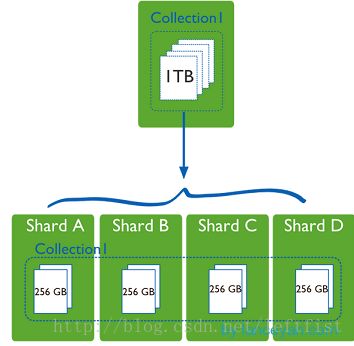分片集群结构分布:
分片集群主要由三种组件组成:mongos,config server,shard
1) MONGOS
数据库集群请求的入口,所有的请求都通过mongos进行协调,不需要在应用程序添加一个路由选择器,mongos自己就是一个请求分发中心,它负责把对应的数据请求请求转发到对应的shard服务器上。在生产环境通常有多个mongos作为请求的入口,防止其中一个挂掉所有的mongodb请求都没有办法操作。
2) CONFIG SERVER
顾名思义为配置服务器,存储所有数据库元信息(路由、分片)的配置。mongos本身没有物理存储分片服务器和数据路由信息,只是缓存在内存里,配置服务器则实际存储这些数据。
mongos第一次启动或者关掉重启就会从 config server 加载配置信息,以后如果配置服务器信息变化会通知到所有的 mongos 更新自己的状态,这样 mongos 就能继续准确路由。在生产环境通常有多个 config server 配置服务器,因为它存储了分片路由的元数据,这个可不能丢失!就算挂掉其中一台,只要还有存货, mongodb集群就不会挂掉。
3) SHARD
这就是传说中的分片了。
如图所示,一台机器的一个数据表 Collection1 存储了 1T 数据,压力太大了!在分给4个机器后,每个机器都是256G,则分摊了集中在一台机器的压力。
事实上,上图4个分片如果没有副本集(replica set)是个不完整架构,假设其中的一个分片挂掉那四分之一的数据就丢失了,所以在高可用性的分片架构还需要对于每一个分片构建 replica set 副本集保证分片的可靠性。生产环境通常是 2个副本 + 1个仲裁。
2、 搭建分片
假设我们要配置如下图所示的一个分片集群

因为没有足够的机器,现在都部署于同一台机器上,通过不同端口来进行划分:
| “机器”一 | “机器”二 | “机器”三 | |
| mongos | 20000 | 20001 | 20002 |
| config | 30000 | 30001 | 30002 |
| shard | 40000,40001(副本),40002(仲裁) | 41000,41001(副本),42002(仲裁) | 42000,42001(副本),42002(仲裁) |
1) 启动配置服务器
示例,启动3台“机器”的配置服务器:
mongod --configsvr --dbpath config\1\data --port 30000 --logpath config\1\log\config.log
mongod --configsvr --dbpath config\2\data --port 30001 --logpath config\2\log\config.log
mongod --configsvr --dbpath config\3\data --port 30002 --logpath config\3\log\config.log
2) 启动MONGOS服务器
示例,启动3台“机器”的mongos,jsj-1306-201是在下电脑的机器名:
mongos --configdb jsj-1306-201:30000,jsj-1306-201:30001,jsj-1306-201:30002 --port 20000 --logpath mongos\1\log \mongos.log
mongos --configdb jsj-1306-201:30000,jsj-1306-201:30001,jsj-1306-201:30002 --port 20001 --logpath mongos\2\log \mongos.log
mongos --configdb jsj-1306-201:30000,jsj-1306-201:30001,jsj-1306-201:30002 --port 20002 --logpath mongos\3\log \mongos.log
3) 启动分片及其副本集实例
shard1:
mongod --shardsvr --replSet shard1 --port 40000 --dbpath shard\1\data --logpath shard\1\log\shard.log --nojournal --oplogSize 10
mongod --shardsvr --replSet shard1 --port 40001 --dbpath shard\1_1\data --logpath shard\1_1\log\shard.log -- nojournal --oplogSize 10
mongod --shardsvr --replSet shard1 --port 40002 --dbpath shard\1_2\data --logpath shard\1_2\log\shard.log -- nojournal --oplogSize 10
shard2:
mongod --shardsvr --replSet shard2 --port 41000 --dbpath shard\2\data --logpath shard\2\log\shard.log --nojournal --oplogSize 10
mongod --shardsvr --replSet shard2 --port 41001 --dbpath shard\2_1\data --logpath shard\2_1\log\shard.log -- nojournal --oplogSize 10
mongod --shardsvr --replSet shard2 --port 41002 --dbpath shard\2_2\data --logpath shard\2_2\log\shard.log -- nojournal --oplogSize 10
shard3:
mongod --shardsvr --replSet shard3 --port 42000 --dbpath shard\3\data --logpath shard\3\log\shard.log --nojournal --oplogSize 10
mongod --shardsvr --replSet shard3 --port 42001 --dbpath shard\3_1\data --logpath shard\3_1\log\shard.log -- nojournal --oplogSize 10
mongod --shardsvr --replSet shard3 --port 42002 --dbpath shard\3_2\data --logpath shard\3_2\log\shard.log -- nojournal --oplogSize 10
4) 启动分片副本集
登录各个副本集中的任意实例,进行副本集初始化
config={_id:"shard1",members:[
{_id:0,host:"jsj-1306-201:40000","priority":2},
{_id:1,host:"jsj-1306-201:40001"},
{_id:2,host:"jsj-1306-201:40002",arbiterOnly:true}
]
}
config={_id:"shard2",members:[
{_id:0,host:"jsj-1306-201:41000",arbiterOnly:true},
{_id:1,host:"jsj-1306-201:41001","priority":2},
{_id:2,host:"jsj-1306-201:41002"}
]
}
config={_id:"shard3",members:[
{_id:0,host:"jsj-1306-201:42000"},
{_id:1,host:"jsj-1306-201:42001",arbiterOnly:true},
{_id:2,host:"jsj-1306-201:42002","priority":2}
]
}
详细操作方法参考副本集
5) 设置分片,让分片生效
连接mongos,比如
mongo jsj-1306-201:20000
use admin
db.runCommand({addshard:"shard1/jsj-1306-201:40000,jsj-1306-201:40001,jsj-1306-201:40002"});
db.runCommand({addshard:"shard2/jsj-1306-201:41000,jsj-1306-201:41001,jsj-1306-201:41002"});
db.runCommand({addshard:"shard3/jsj-1306-201:42000,jsj-1306-201:42001,jsj-1306-201:42002"});
6) 查看分片
在mongos下
db.runCommand( { listshards : 1 } );
3、 测试分片
在mongos下:
mongos> use test
switched to db test
mongos> use admin
switched to db admin
mongos> db.runCommand({enablesharding:"testdb"});
{ "ok" : 1 }
mongos> db.runCommand({shardcollection:"testdb.table1",key:{id:1}});
{ "collectionsharded" : "testdb.table1", "ok" : 1 }
mongos> use testdb;
switched to db testdb
mongos> for(var i=1;i<=100000;i++) db.table1.save({id:i,"test1":"testval1"});
查阅数据分布情况:
mongos> db.table1.stats();
4、 查阅分片信息
分片集群的信息保存在congfig服务器,名为config的数据库里。通过mongos可以进行访问。
mongos> use config
1) 查询当前的版本
mongos> db.getCollection("version").findOne()
2) 查询当前的配置CHUNKSIZE的大小
mongos> db.settings.find()
3) 查询整个SHARD集群的成员
mongos> db.shards.find()
4) 查询被水平拆分的集合:
mongos> db.collections.find()
5) 查询被水平拆分的集合分成的CHUNK分布
mongos> db.chunks.find()
6) 查询当前MONGODB里面的数据库的SHARD信息:
mongos> db.databases.find()
7) 查询MONGOS集合
mongos> db.mongos.find()
8) 查看整个MONGODB 数据库SHARD的详细信息
mongos> printShardingStatus();
参考文章:
http://www.lanceyan.com/tech/arch/mongodb_shard1.html
http://blog.itpub.net/22664653/viewspace-710281/

